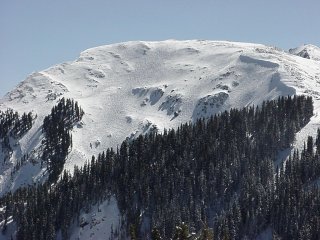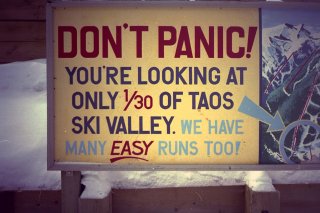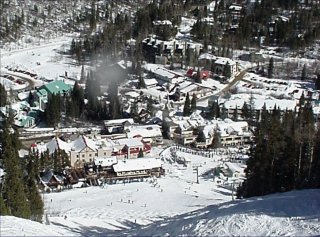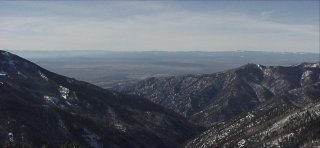Story by Matt Duffy
Photos by Marc Guido
(February 2001) – It took a lot to get here, which says
nothing about the easy access to Taos. Planning for a full season of features
at First Tracks!! Online began while I was
laid up and recovering from ACL surgery. I was in severe snow-withdrawal,
and despite the question marks lining my upcoming winter; I went ahead and
committed to a February visit to New Mexico’s Sangre de Cristo Mountains.
It was an optimistic impulse, driven by the obsessive planning that we snow
addicts partake of in every off-season.
n
|
|
When the time came, however, I had exceeded
all recovery goals and was more than ready for the trip. Two words repeated
themselves in my mind as the date grew near: Kachina Peak. The highest point
at Taos Ski Valley was beckoning. I had seen the pictures. I had read with
great interest. Teasing /images of vast, open steeps covered in deep, light
powder. Skiers leaving white glitter-plumes in their wake, sparkling in bright
sunlight under blue sky. I was chomping at the bit to get atop that peak.
And I still am. The chance to hike Kachina
Peak arose on the first ski day at Taos, but we had so much fun exploring
the mountain’s other nooks and crannies, and tiring ourselves out in the process,
that it didn’t seem like a big deal to wait until the next day. When that
tomorrow came, however, it snowed all morning. Ski Patrol is cautious about
opening up the Peak’s access gates during periods of low visibility. Even
on the typical sunny New Mexican day, the gate to Kachina clinks shut at 1
p.m., as conducting a sweep on such a huge expanse of terrain is very time
consuming. Hey, next time… It wasn’t so bad having a fresh powder day in seemingly
omnipresent hidden inbounds treasures. Each exploration of the woods between
Taos Ski Valley’s trails was rewarded with sweet, untouched lines that sometimes
bear resemblance to the density of classic New England tree skiing
When all was said and done, and all of the
dust had settled, the two days spent at Taos Ski Valley stand tall among the
cold cornucopia of highlights that was my 2000-01season. Half way through
the first day I proclaimed, "I think I’ve got a new favorite mountain!"
Adriana Mount-Blake smiled with a knowing sense of pride. I’m betting that
she’s heard that one before.
You see, Adriana is the granddaughter of the
legendary Ernie Blake, the man who flew over these mountains roughly fifty
years ago, noting with deep interest the potential for some great skiing.
She’s been here all her life, and her grandfather was right. The resort has
been in the Blake family’s hands since the beginning, and is now headed by
Ernie’s son and Adriana’s father, Mickey Blake.
Adriana spent the day with us on skis, sharing
the magic of the place she calls home. The conversations about Taos during
chairlift rides ran the gamut. Did you know that Ernie Blake was an interrogator
for the US Army during WWII? Hike to the ridgeline above the #2 lift, hang
a left, and you’ll find faces with the Spanish trail names that you’d expect
from such a colorful regional culture. Turn right, however, and you’ll find
a vast array of chutes named for some of the German Generals that Blake interrogated
during the forties. Adriana imparted a lot of information regarding Taos on
the lift, but the real beta was to be discovered via the non-conversational
communication between skier and mountain. There is only one way to truly
get to know a mountain, and it’s not through talking about it!
You can tell me that this is one of the sunniest
places in the U.S. (88% of days feature sunshine), but those are just words.
The familiar coconut smell of sunscreen and skin peeling from my nose told
me all about it in vivid detail, as I constantly squinted to soothe my light-sensitive
eyes. And telling me that 300 or more inches of snow fall here each year does
very little, compared to showing me a favorite powder stash and turning me
loose!
What about Taos’ oft-cited ban on snowboarding?
If you don’t like it, I’ve got two words for you: ¡mala suerte! These,
of course, are my words, and in no way do they represent those of Taos
Ski Valley, the state of New Mexico, my neighbor’s dog, or anyone else in
any way. There are very valid reasons for the prohibition, however. Taos’
trail network funnels into an area near the base that becomes very congested
on busy days. Introducing an entirely different traffic pattern to this area
would be cause for alarm. Before you suggest blasting out new trails to accommodate
the changes, it cannot happen – both from a moral standpoint, and from the
fact that it’s just not topographically feasible. The lay of the land is such
that room for alternatives doesn’t exist. Finally, in my opinion, Taos is
one of those precious few places that have not yet sold out to the almighty
dollar. It is a piece of skiing history, built by skiers, for skiers. The
mountain is still pure. Homogenizing it would be the crime of the century.
A MOUNTAIN OF SUPERLATIVES
Typical brochure writing doesn’t differ all
that much from the cliché quotes that you’ll find on the cover of a rental
video, on the back of a best selling novel, or in annual ski magazine reader
surveys. Such mundane locations are usually also home to various statistics
and rankings meant only to establish some generic frame of reference. They
try to tell you what is good, and what isn’t. Apples and oranges. Chile peppers
and maple syrup. Whatever.
While I must admit that statistics and ratings
mean far less to me than to the average person, what do they mean to anyone
whose breath has just been taken away by something beautiful? Seduced by wonderful
discoveries at every turn, the mind filled with wordless admiration and inspired
with the excitement of skiing one’s self to bliss. It’s like falling in love.
That says more to me about skiing Taos than any facts or figures ever could.
Was I concerned about 300,000 annual skier visits while weaving down the maze
of steeps that is West Blitz Trees, sending white ripples left and right with
watering eyes and a fast-beating heart? Hell, no! When trees are whizzing
by the corners of one’s eyes, focus is only on the next opening, anticipating
and skiing by feel as much as by the blurry tunnel vision that is soulful,
unspoiled tree skiing. Not knowing what’s over the next sheer pitch, but trusting
that improvisational body language can and will occur in a place that allows
for speed and a margin for error. The trust gained through an abstract communication
with terrain, reading the patterns and exploring the possibilities. You figure
out when to demonstrate humble respect, and when to open up and make that
powder explode. You’ll find the good vibes radiating from most everything
at Taos.
You can read testimonials that explain why
the Ernie Blake Ski School is ranked #1 in the nation in a survey conducted
of its industry peers, but such rave reviews do nothing to prepare you for
the learning experience that you’ll find there. You can marvel at Taos Ski
Valley’s high rankings for their bumps and steeps, but you haven’t learned
a thing about the resort’s moguls until your quads are burning halfway through
the zipper-line marathon that is Longhorn.
No words written anywhere can transfer to
you the feeling you get when you’re standing atop a snow-coverd ridge and
staring out across miles and miles of desert, and when the gawking is done,
turning toward a cornice and preparing to drop into the steep bowl of Juarez.
Bending knees, lowering center of gravity, loading up with energy. Popping
up, uncoiling, turning in the air and falling away over the edge. An instant
of freefall, frozen in the air, surrounding details warped to a blur, time
stretching out of focus. The blur follows everything like tracers until abruptly
all objects stop when the turn is complete and the blurs catch up with their
origins. All snaps back into itself and the heart ticks faster and faster
… Knees bend dynamically, absorbing energy of impact before a rebounding,
uncoiling surge of energy drives forward and out into shallow air and the
race is on. A sunlit cloud of smoke follows the fast moving self, skipping
over troughs with knees absorbing and uncoiling up and down, up and down,
destroying loose powder pillows one after another, ad infinitum. Poof-poof-poof-poof-poof,
banshee scream, poof-poof-poof-poof-poof… gone.
You can read about the intimidating first
impression you’ll get of Taos, but it won’t mean much to you until you actually
pull into the parking lot, look up and see that within a short distance, the
top of the run disappears over a distinct horizon line where deep blue meets
pure white.
There’s a nostalgic little sign at the mountain’s
base that reads, "Don’t panic! You’re looking at only 1/30 of Taos Ski
Valley. We have many easy runs too!" Adriana did mention that
the reputation of challenging steeps at times is an obstacle to drawing families
and beginners to Taos. That’s unfortunate, because I know a particular beginner
and some intermediates whom all enjoyed a great time at the resort. Despite
the fact that a full 56% of Taos’ marked runs are decorated by diamonds, the
#4, #7 and #8 chairs carry skiers to broad expanses of blue and green terrain
high on the mountain, and true beginners have their own little corner of the
world adjacent to the hotels in the village, served by its own collection
of two chairlifts and two magic carpets.
A
CROSS-CULTURAL EXPERIENCE
|
|
Blake carried a bit of Austria and dropped
it at the top of a narrow valley nestled between the steep lower slopes of
the Sangre de Cristos. Taos Ski Valley is home to nearly twenty inns, lodges,
hotels and B&Bs with such names as the Innsbruck Lodge, The Bavarian Lodge,
the Hotel Edelweiss, and the Hotel St. Bernard, all with unexpectedly Tyrolean
architecture. Many properties offer meal plans, and all are individually
owned. Flatlanders and party hounds beware, because you’ll find it wonderfully
quiet at night here in the rarified high-altitude air with its incumbent lack
of oxygen.
Nineteen miles down the valley, two thousand
feet lower and culturally half a planet away, the city of Taos lies on the
edge of a broad expanse of New Mexico desert. This is the heart of New Mexico’s
famed Enchanted Circle. A mix of trendy galleries and native honesty, Taos
offers a decidedly different experience from that offered by most western
ski towns. Dining choices are endless, ranging from haute cuisine to Mexican
greasy spoons. Lodging opportunities span from economy motels to quaint B&Bs
and full-service hotels. Most of Taos’ buildings sport the uniquely southwestern
adobe construction, but for a true taste of the area’s history, wander the
few miles north to Taos Pueblo and step back in time while keeping your other
foot in the present. Stroll the streets surrounding Taos Plaza. Squeeze
into the tiny Eske’s Brew Pub for some local suds. Visit Kit Carson’s home.
Email jealous friends back home from the free public access at La Plaza.
Dine on copious but inexpensive native fare at El Taoseño, as a local couple
celebrates their wedding reception in the back room.
Broaden your horizons while you’re in the
area, too. Within a half-hour’s drive, Angel Fire Resort and Red River Ski
Area offer sliding alternatives, while Ski Santa Fe lies slightly further
afield to the south. Most skiers fly to Taos via the Albuquerque International
Sunport (airport) an easy 148 miles to the south. If you prefer to not rent
a car, Faust’s Transportation (505-758-3410) and Pride of Taos (800-273-8340)
both offer daily shuttle service to and from the airport in Albuquerque. However,
the 2000-2001 ski season saw the debut of seasonal direct air service from
Dallas/Ft. Worth into the airport in Taos, a joint venture between Angel Fire
and Taos Ski Valley on Ozark Airlines charter planes. Rio Grande Air also
makes the trip between Albuquerque and Taos in 40 minutes flat, and American
Eagle’s commuter service is reportedly looking carefully into adding service
to Taos.
I can only give you my perspective on Taos,
but don’t take my word for it, or anyone else’s. Once you’ve been there, only
your perspective will matter.








